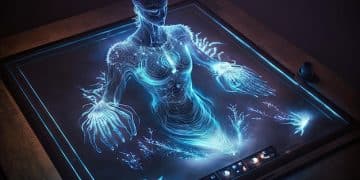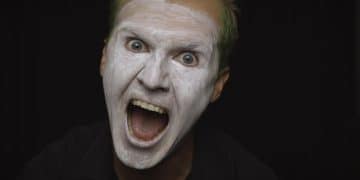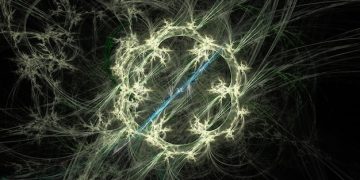Tech & Sleep: Improve Quality, Reduce Insomnia
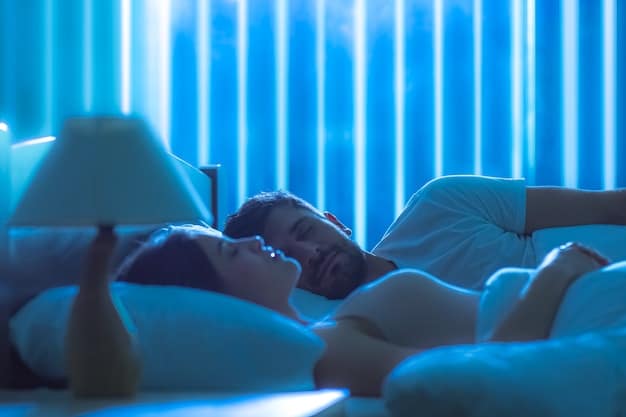
Technology offers a promising frontier in enhancing sleep quality and mitigating insomnia by providing precise tracking, personalized interventions, and environmental controls that align with the intricate mechanisms of human sleep cycles.
For many, the elusive promise of a truly restorative night’s sleep remains just that—a promise. Yet, as our understanding of sleep deepens, so too does the potential for innovative solutions. The science of sleep: how can technology improve sleep quality and reduce insomnia? is a question no longer confined to theoretical discussions but is actively being explored through groundbreaking technological advancements.
Understanding the Sleep Landscape: Why Quality Matters
Sleep is not merely a period of inactivity; it is a vital biological process essential for physical and mental restoration. During sleep, our bodies repair cells, consolidate memories, and regulate hormones. Chronic sleep deprivation, conversely, is linked to a host of health problems, including increased risk of cardiovascular disease, diabetes, obesity, and impaired cognitive function.
Insomnia, affecting millions globally, represents a significant barrier to achieving adequate sleep. It manifests in various forms, from difficulty falling asleep to frequent awakenings, and its impact extends far beyond nighttime hours, influencing mood, productivity, and overall quality of life. Addressing sleep quality, therefore, is not a luxury but a fundamental component of holistic health. The intricate dance of sleep stages—from light sleep to deep sleep and REM—is crucial for these restorative processes, and disruptions can severely compromise their effectiveness.
The Biological Imperative of Sleep
Our circadian rhythm, an internal 24-hour clock, dictates our sleep-wake cycles, responding primarily to light and darkness. When this rhythm is disrupted, through shift work, jet lag, or inconsistent sleep schedules, sleep quality suffers. Melatonin, often called the “sleep hormone,” plays a critical role in signaling to the body that it’s time to rest.
- Cognitive Function: Sleep enhances memory consolidation and learning abilities.
- Emotional Regulation: Adequate sleep helps in processing emotions and reduces irritability.
- Physical Health: Sleep supports immune function and regulates metabolism.
Understanding these foundational biological mechanisms provides the basis for how technology can intervene effectively. By mimicking natural cues or counteracting disruptive elements, tech solutions aim to realign our physiology with optimal sleep patterns.
Common Sleep Disruptors and Their Impact
Modern life introduces numerous factors that actively hinder good sleep. Stress from work or personal life often leads to racing thoughts at bedtime. Exposure to blue light from screens, especially in the evening, suppresses melatonin production, signaling to the brain that it’s still daytime. Caffeine and alcohol consumed too close to bedtime can fragment sleep, preventing deep restorative stages. Noise, an uncomfortable sleep environment, and even certain medical conditions also contribute significantly.
Recognizing these prevalent disruptors is the first step in devising strategies for mitigation, and technology offers a diverse toolkit for this purpose. By analyzing individual patterns and environmental factors, personalized solutions can be implemented to address specific challenges, paving the way for more consistent and higher-quality sleep.
Smart Sleep Tracking: Unveiling Your Nighttime Habits
One of the most significant contributions of technology to sleep improvement is its ability to track and analyze sleep patterns. Gone are the days of guessing how well you slept; smart devices now provide objective data, offering insights into sleep duration, stages, and disturbances. This data empowers individuals to understand their unique sleep architecture.
These trackers typically utilize accelerometers, heart rate sensors, and even sound analysis to paint a comprehensive picture of the night. From wearable rings and watches to under-mattress sensors, the options are diverse, catering to different preferences and comfort levels. The raw data, however, is just the beginning; the real value lies in the actionable insights derived from it, which can guide behavioral changes and therapeutic interventions.
Wearable Devices and Their Metrics
Popular wearables like smartwatches and fitness trackers are often equipped with advanced sleep tracking capabilities. They monitor motion, heart rate variability, and sometimes even blood oxygen levels to estimate sleep stages (light, deep, REM). While not as precise as clinical polysomnography, they offer a convenient and continuous way to observe sleep trends over time.
- Sleep Score: A composite metric summarizing overall sleep quality.
- Time in Bed vs. Actual Sleep: Differentiating between rest and wakefulness.
- Awakenings: Identifying periods of restlessness or full awakenings during the night.
The consistent collection of these metrics helps users identify patterns, such as how late-night eating affects deep sleep or how stress elevates heart rate during sleep. This self-awareness is a powerful tool in the journey toward better sleep hygiene.
Non-Wearable Sleep Trackers
For those who prefer not to wear devices to bed, non-wearable options provide an equally insightful alternative. These include sensors placed under the mattress, bedside devices, or even specialized pads. They often monitor breathing, heart rate, and movement without direct physical contact.
Some advanced non-wearable trackers can even detect snoring or sleep apnea symptoms, alerting users to potential underlying health issues that require medical attention. The benefit here is convenience and a less intrusive experience, making it easier for individuals to consistently track their sleep without changing their nightly routine.
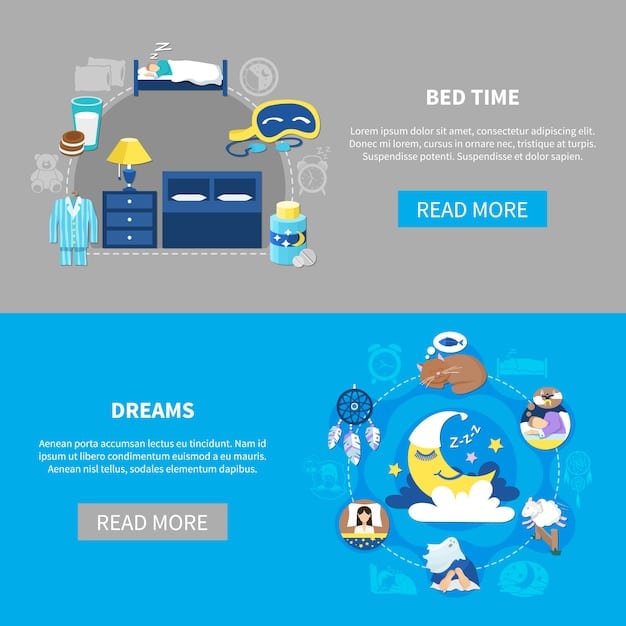
Personalized Interventions: Tailoring Sleep Solutions
Beyond tracking, technology is moving towards personalized interventions designed to guide individuals toward better sleep. This shift from generic advice to tailored solutions acknowledges that sleep issues are highly individual and require nuanced approaches. These interventions often leverage data collected from tracking devices to offer specific, contextualized recommendations.
From smart alarms that wake you in your lightest sleep stage to AI-driven coaching apps, the goal is to create a dynamic and responsive system that adapts to the user’s specific needs and evolving sleep patterns. This level of customization sets modern tech solutions apart, fostering a more effective path to improved sleep.
Smart Alarms and Wake-Up Lights
Waking up during a deep sleep stage can lead to grogginess and a poor start to the day. Smart alarms address this by monitoring your sleep cycles and waking you during a prime “light sleep” window within a set timeframe. This aims to replicate the feeling of naturally waking up refreshed.
Coupled with wake-up lights, which simulate a sunrise, these systems gently bring you out of sleep, aligning with your natural circadian rhythm. The gradual increase in light encourages a more natural awakening by gradually suppressing melatonin production, making the morning transition smoother and more energized.
AI-Powered Sleep Coaching and Apps
Artificial intelligence is transforming sleep improvement by providing personalized coaching and adaptive programs. These apps analyze your sleep data, daily habits, and stated goals to offer bespoke advice, sleep schedules, and even therapeutic exercises. They can identify trends, such as consistent late-night scrolling leading to delayed sleep onset, and suggest specific behavioral changes.
Some apps incorporate cognitive behavioral therapy for insomnia (CBT-I) principles, guiding users through structured programs to address anxiety around sleep and unhealthy sleep habits. The continuous feedback loop and adaptive nature of AI make these tools highly effective in fostering sustainable changes for better sleep.
Optimizing the Sleep Environment with Smart Home Tech
The bedroom environment plays a crucial role in sleep quality. Technology now allows for comprehensive control over various environmental factors, transforming a standard bedroom into a sophisticated sleep sanctuary. Smart home integration ensures that lighting, temperature, and even sound contribute optimally to restorative sleep.
By automating these elements, individuals can create a consistent and conducive ambiance that primes their brains and bodies for rest, minimizing external disruptions. This proactive approach to environmental control is a powerful ally in the fight against insomnia and poor sleep.
Smart Lighting and Blue Light Filters
Light is the most potent external cue for our circadian rhythm. Smart lighting systems can be programmed to dim and shift to warmer tones in the evening, signaling to the body that it’s time to wind down. In the morning, they can gently brighten, mimicking a natural sunrise.
Blue light, emitted most predominantly from screens, is particularly disruptive to melatonin production. Technology offers solutions ranging from setting night shifts on devices, which filter blue light, to specialized glasses that block these wavelengths. These measures are critical for maintaining healthy sleep-wake cycles in our screen-centric world.
Temperature Regulation and Smart Beds
An optimal sleep temperature is crucial for falling and staying asleep. Smart thermostats can be programmed to adjust the bedroom temperature throughout the night, ensuring comfort during different sleep stages. Variations in body temperature naturally occur during sleep, and maintaining a cool environment aids in temperature regulation.
Advanced smart beds take this a step further by offering personalized temperature control zones, allowing partners to customize their side of the bed. Some even feature adjustable firmness, anti-snoring functions, and dynamic support to optimize comfort and minimize disruptions, creating an unparalleled sleep experience tailored to individual needs.
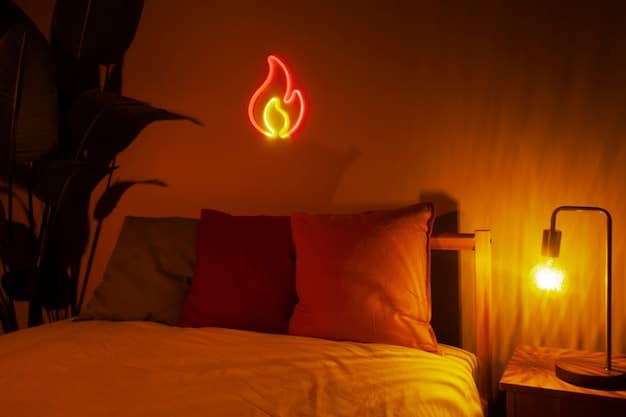
Beyond Tracking: Advanced Technologies for Insomnia
While tracking and environmental adjustments are beneficial, technology is also venturing into more direct therapeutic applications for insomnia and severe sleep disorders. These advanced solutions often bridge the gap between consumer tech and clinical interventions, offering new avenues for relief for those who struggle significantly.
From devices that stimulate specific brain frequencies to sophisticated diagnostic tools, the innovation in this space is rapidly expanding, promising more effective and accessible treatments for complex sleep challenges. These technologies represent a critical step forward in addressing the root causes of sleep disturbances.
Sound Therapy and White Noise Machines
Sound can be a powerful tool for sleep, either as a disruptive force or a calming aid. White noise machines and sound therapy devices generate consistent background sounds that mask sudden noises, creating a tranquil environment. This promotes a feeling of security and helps the brain filter out distracting auditory stimuli.
Some devices offer a range of sounds, from nature soundscapes to binaural beats, which are designed to entrain brainwaves to frequencies associated with relaxation and deep sleep. This non-invasive approach helps many individuals calm their minds and drift off to sleep more easily, particularly in noisy environments.
CBT-I Apps and Telehealth for Insomnia
Cognitive Behavioral Therapy for Insomnia (CBT-I) is considered the gold standard treatment for chronic insomnia. Traditionally delivered by therapists, technology has made CBT-I more accessible through dedicated apps and telehealth platforms. These digital programs guide users through structured exercises to identify and change thoughts and behaviors that interfere with sleep.
Telehealth platforms also connect patients directly with sleep specialists, removing geographical barriers and making expert advice more readily available. This blend of structured therapy with convenient access is revolutionizing how insomnia is treated, empowering more individuals to receive effective, evidence-based care.
Future of Sleep Technology: What’s Next?
The pace of innovation in sleep technology shows no signs of slowing. As our understanding of sleep neuroscience deepens and artificial intelligence becomes more sophisticated, we can anticipate a new generation of devices and interventions. The future promises even greater personalization, predictive capabilities, and seamless integration into our daily lives, making optimal sleep an achievable reality for more people.
Expect more advanced biofeedback mechanisms, smart textiles, and even more sophisticated diagnostic wearables that offer clinical-grade accuracy at home. The ultimate goal is a holistic ecosystem that not only tracks but actively optimizes every aspect of sleep, tailoring solutions with unprecedented precision.
Predictive Sleep Analytics and AI
Current sleep trackers provide retrospective data, showing you how you slept. The next frontier is predictive analytics. AI will analyze large datasets, including your historical sleep, daily activities, diet, and even weather patterns, to predict potential sleep disruptions before they occur.
Imagine receiving a notification that, based on your activity levels and caffeine intake, you might struggle to fall asleep tonight, along with a recommendation for a wind-down routine. This proactive approach will allow individuals to preemptively adjust their habits, preventing sleep issues rather than just reacting to them.
Neuromodulation and Advanced Biofeedback
Emerging technologies are exploring direct brain intervention to improve sleep. Neuromodulation devices, such as transcranial direct current stimulation (tDCS) or transcranial magnetic stimulation (TMS), are being researched for their potential to influence brainwave activity associated with deep sleep and relaxation. While still largely experimental, these non-invasive techniques could offer powerful new therapeutic avenues.
Advanced biofeedback systems will also become more common, providing real-time physiological data (e.g., heart rate variability, skin conductance) and guiding users through exercises to achieve states conducive to sleep. By offering immediate feedback, these systems empower individuals to gain greater conscious control over their body’s relaxation responses.
Integrated Sleep Ecosystems
The future of sleep technology will likely involve a seamless integration of various devices and platforms into a cohesive “sleep ecosystem.” Your smart bed might communicate with your wearable, which in turn syncs with your smart home lighting and thermostat, all working in concert to optimize your sleep environment and routine.
This holistic approach will create a truly personalized and responsive sleep experience, where technology anticipates your needs and actively adjusts to ensure the best possible night’s rest. The fragmentation of current devices will give way to a harmonious network, making optimal sleep effortless and automatic.
| Key Aspect | Brief Description |
|---|---|
| 😴 Sleep Tracking Devices | Wearables and non-wearables provide objective insights into sleep patterns, stages, and disturbances. |
| 💡 Environmental Optimization | Smart lighting, temperature control, and sound systems create an ideal sleep sanctuary. |
| 🧠 Personalized Interventions | AI-driven apps and smart alarms offer tailored advice and gentle wake-ups based on data. |
| 🚀 Future Innovations | Predictive analytics, advanced biofeedback, and integrated ecosystems promise even better sleep solutions. |
Frequently Asked Questions About Sleep Technology
▼
Consumer sleep trackers provide valuable insights into sleep patterns, but they are generally less accurate than clinical polysomnography (PSG). While good for tracking trends and identifying potential issues, they should not replace professional medical diagnosis for sleep disorders. Their algorithms estimate sleep stages based on movement and heart rate, which differs from the brain wave analysis used in PSG.
▼
While technology can significantly improve sleep quality and manage insomnia symptoms, it is not a standalone “cure” for chronic insomnia. Cognitive Behavioral Therapy for Insomnia (CBT-I), whether delivered via apps or telehealth, is an evidence-based treatment. Technology acts as a powerful tool to support behavioral changes, create an optimal sleep environment, and provide data for personalized interventions.
▼
Improving deep sleep often involves a combination of environmental and behavioral interventions. Technologies that optimize the sleep environment, such as smart temperature control and light management, are highly effective. Additionally, devices that provide sound therapy, like white noise machines or those offering binaural beats, can help facilitate a deeper, more restorative sleep state by blocking disruptions and promoting relaxation.
▼
Over-reliance on sleep technology can lead to “orthosomnia,” an unhealthy obsession with achieving “perfect” sleep metrics, potentially increasing anxiety around sleep. Data accuracy can vary, and misinterpreting data without professional guidance might lead to inappropriate conclusions or self-treatment. It’s crucial to use technology as a supportive tool for self-awareness and improvement rather than a source of stress.
▼
Choosing the right sleep technology depends on your specific issues and preferences. If you want to understand your sleep cycles, a tracker is suitable. If environmental factors are disruptive, smart home devices are beneficial. For chronic insomnia, look for apps that incorporate CBT-I principles or facilitate telehealth. Consider comfort, ease of use, data privacy, and budget when making your decision.
The Dawn of Restorative Sleep
The journey toward superior sleep quality is undeniably being reshaped by technological innovation. From the precision of smart trackers unveiling our nighttime rhythms to the intelligent ambiance created by automated environments, technology offers a robust toolkit for mitigating insomnia and enhancing restorative rest. As these tools become more integrated and intuitively responsive, the power to reclaim peaceful, rejuvenating sleep shifts increasingly into our hands. The future promises an even deeper synergy between human biology and advanced engineering, leading us towards an era where optimal sleep is not just a dream, but a widespread reality.

